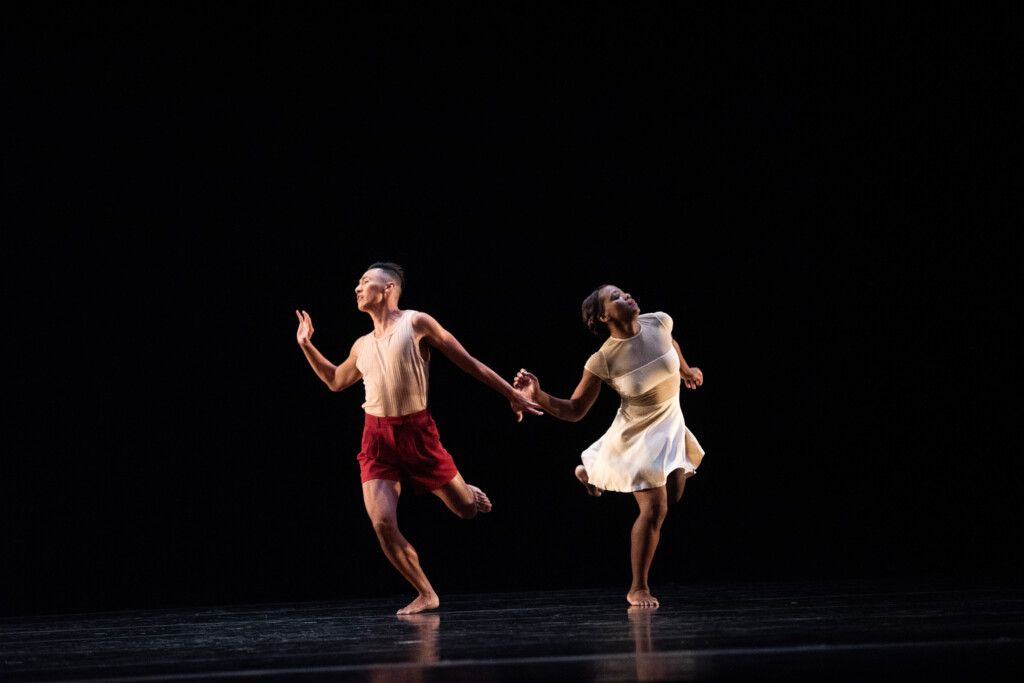Invigorated and sharp in every moment of the trio of works by choreographer Noa Zuk, the Repertory Dance Theatre’s (RDT) dancers put on a master class about the Gaga movement language to open the company’s 59th season.
This season’s theme is Reflection, as the company paves the path for the forthcoming 60th anniversary celebration in the 2025-2026 season. It was the perfect start to highlight the decade-long relationship RDT has cemented with the Israeli choreographer. RDT dancers have worked with numerous movement languages from scores of choreographers but it also is noteworthy how the dancers have consistently taken so easily to the agile and physically vigorous spectrum of the Gaga movement language. RDT newcomer Alexander Pham, in a program note, articulated a sentiment that company dancers over the last decade have learned to appreciate about this particular movement language: “Working with Noa [Zuk] was one of those moments where you experience how someone’s lifelong commitment to their craft (Gaga) has informed their entire being and approach. She is so articulate in both her words and in her body that when she tells and shows you how to jump through space towards your partner as if you are shedding all the dust off your skin, you know exactly what she means and what sensation to continually search for. You always know what every movement should feel and sound like.”

The physical evidence of Pham’s words came through impressively. The opening work, By The Snake, which RDT commissioned ten years ago from Zuk, has been performed periodically since then. But, this latest performance seemed even crisper, more incisive and exhilarating than others. With the eight dancers paired in four couples, the work took on a polyglot character, by riffing off folk dance conventions and creating a new foundation for a contemporary ritual on the dance floor. Ursula Perry and Daniel Do led off by liberating the movement from strict mirroring and unison features while demonstrating a more richly textured interaction that suggests how the couple converse with each other on the dance floor. The myriad of expressions expanded, as the other couples joined on stage (Caitlyn Richter and Jacob Lewis, Megan O’Brien and Caleb Daly, and Lindsey Faber and Alexander Pham). The soundtrack, composed by Ohad Fishof, Zuk’s creative partner, is not tied to a specific style or culture as much as it is to a universally accessible rhythmic pulse.
The variety of movement the dancers display was just as impressive in Outdoors, a work that Zuk and Fishof initially restaged on RDT, five years ago. Outdoors is the first half of Shutdown that premiered in Germany the prior year (2018). The music for Outdoors is a 15-second rhythmic ‘sentence’ that repeats itself 60 times in many variations. As noted in the preview published at The Utah Review, the premise for Outdoors is simple: a concise rhythmic idea where the variations are represented by movement and sound. The work becomes a unique naturally occurring story every time it is performed. Outdoors suggests how the body feels when it is at its height of its physical capacities and capabilities but also finds ways to compensate and keep up the vigor, while the biological clock continues to tick toward its inevitable mortality. The dancers displayed incredible control in emulating this physiological trajectory while staying on pace to the relentless loop of Fishof’s short rhythmic sentence.
Rounding out the production was the Utah premiere of Gringo, as seven-minute snippet from a 2014 work by Zuk, with the curiously lengthy title An Old Woman Picking Up A Stone From The Ground And Carrying It Back To Her House. The closing night audience endorsed the performance of this piece with a standing ovation. The first section was a duet showcasing the finesse and expertise that Do and Pham have found with the Gaga movement language and its theatrical character, while the second section brought the entire company on stage for one more exhilarating display of a language that has resonated with them.
In recorded video clips interspersed between the works performed, Zoa spoke about how Gaga counters the effects of becoming lazy because we defer to compensating habits and shortcuts. In Mr. Gaga, a 2015 documentary directed by Tomer Heymann and produced by his brother Barak, Ohad Naharin, who directed the Batsheva Dance Company where Zuk had previously been a part of, talked about how he developed Gaga. He developed Gaga as a metaphysical approach to recuperate from a back injury that required surgery. The film opens with a dancer in Israel who is following Naharin’s instructions on how to execute a collapse backward onto the floor. She repeats the move several times, as Naharin criticizes her execution, his voice dripping with dissatisfaction about her inability to translate a typically awkward, ugly movement into artistic expression. Some 100 minutes later, the film closes on a shot of the same dancer onstage executing the collapse perfectly.
This RDT production of Zuk’s work highlighted how these eight dances are at the peak of their physical and artistic powers, fully charged with the stamina they will need for a packed season. This includes an upcoming tour in the northeastern U.S., with stops in Andover, Massachusetts; Hartford Connecticut, and the Whitney Museum of American Art in New York City (see The Utah Review next week for details).
For more information about upcoming productions, workshops and classes, see the RDT website.



